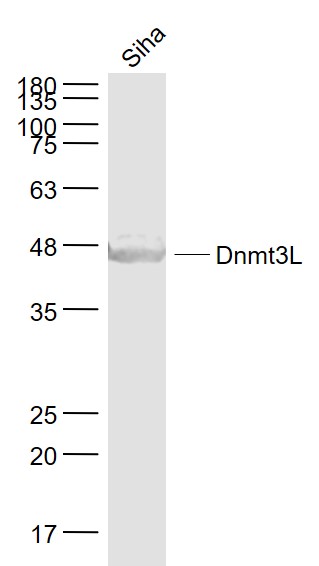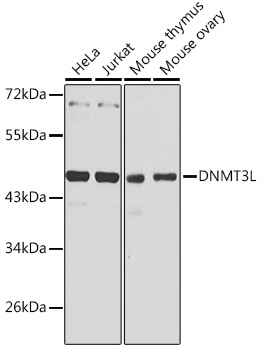Dnmt3L Antibody (OASE00189)
OASE00189
ApplicationsImmunoFluorescence, ImmunoPrecipitation, Western Blot, ImmunoCytoChemistry, ImmunoHistoChemistry, Other Application
Product group Antibodies
TargetDNMT3L
Overview
- SupplierAviva Systems Biology
- Product NameDnmt3L Antibody (OASE00189)
- Delivery Days Customer23
- ApplicationsImmunoFluorescence, ImmunoPrecipitation, Western Blot, ImmunoCytoChemistry, ImmunoHistoChemistry, Other Application
- CertificationResearch Use Only
- ClonalityMonoclonal
- Clone IDS117-9
- Concentration1 mg/ml
- ConjugateUnconjugated
- Gene ID29947
- Target nameDNMT3L
- Target descriptionDNA methyltransferase 3 like
- Target synonymsDNA (cytosine-5)-methyltransferase 3-like, DNA (cytosine-5-)-methyltransferase 3-like, cytosine-5-methyltransferase 3-like protein, human cytosine-5-methyltransferase 3-like protein
- HostMouse
- IsotypeIgG1
- Scientific DescriptionMethylation of DNA at cytosine residues plays an important role in regulation of gene expression, genomic imprinting and is essential for mammalian development. Hypermethylation of CpG islands in tumor suppressor genes or hypomethylation of bulk genomic DNA may be linked with development of cancer. To date, 3 families of mammalian DNA methyltransferase genes have been identified which include Dnmt1, Dnmt2 and Dnmt3. Dnmt1 is constitutively expressed in proliferating cells and inactivation of this gene causes global demethylation of genomic DNA and embryonic lethality. Dnmt2 is expressed at low levels in adult tissues and its inactivation does not affect DNA methylation or maintenance of methylation. The Dnmt3 family members, Dnmt3a and Dnmt3b, are strongly expressed in ES cells but their expression is down regulated in differentiating ES cells and is low in adult somatic tissue (1-6). Studies show that DNMT3L regulates the activity of DNMT3A and DNMT3B and stimulates their catalytic activities (7). DNMT3L has specifically been linked to the process of carcinogenesis, thru its role in nuclear programming (8).
- Storage Instruction-20°C
- UNSPSC12352203







